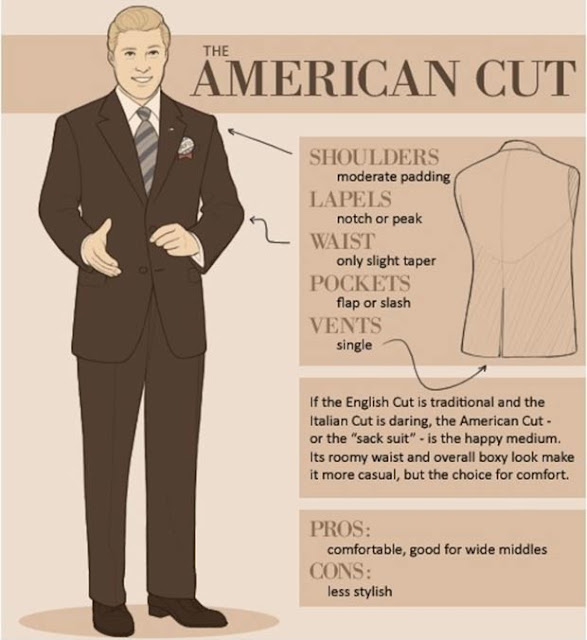The modern suit is the result of a
series of developments that the classic 19th century men’s suit went
through.
The suits we find today are a
combination of technique, cultural aspects and different aesthetic matters that
make them a very advanced form of dressing.
Suits have undergone some rapid
development specially over the last decade, leaving many a perplexed men
unaware of the different types of fits out there for the everyday suit, and we
are here to help.
The fit of a suit is of supreme
importance, and its not too hard to figure out that different body types demand
different fits.
We've put together the three basic fits
for a suit and the body types it flatters to make things much easier for every
gentleman out there.
THE AMERICAN CUT:
A style that rose to
popularity in 1920’s by Ivy Leaguers, the american suit cut has evolved from
being baggy to being cut to the shape of the body. If your the kind of man that
spends hours together in a suit, this cut is the most rewarding due to its boxy
fit that provides that 'oh so comfortable' ease.
The features of the American suit cut are as
follows:
- Commonly
known as the sack suit, this cut features a boxy fit
- Flap
pockets
- wide
lapels that can be either notch or peak.
- Single
vent at the back centre.
- Seen
in either two or three button style
- Wider
cut in the seat of the pants and the shoulders (to accomodate a more
typical American body)
What the sack suit lacks in style, it makes up for
in possessing magical qualities of hiding that extra
holiday weight that your tummy refuses to bid adieu to.
The smaller padding and straighter
cut makes this suit great for middle aged and wider men, creating a uniform
body line.
THE BRITISH CUT:
This distinct style rose to
popularity during the mid 19th century is considered more of a traditional
style. Because it originated in the practices of true
bespoke tailoring, traditional British suiting has a far more ‘fitted’ look
than the mass-produced styles that became emblematic of American style. Cut closer to the body, well tailored with
little or no shoulder padding, this becomes the 'in between' style -
neither boxy nor slim.
These are a few of the distinct characteristics of the traditional british cut:
- Little or no shoulder padding.
- Nipped waist and fitted chest, creates a silhouette that shows of a
slim waist.
- A medium gorge. The gorge is the point in the suit where the
lapels cross when a suit is done up. A low gorge tends to make one
look shorter and draw attention to the tie, while a high gorge brings
attention up to your face, making the medium gorge the perfect sweet
spot.
- Dual vents
- Thin lapels that are either notch or peak.
- A British suit may also have working cuff buttons, called a
"Doctor's Cuff", or ''workable sleeves''.
This cut has the ability to create an illusion of
lengthening and slimming the body down . The
thin lapels, small shoulder, and overall tighter cut of the suit tends to
minimize one's width and accentuate one's height making the dream of 'Tall,
Dark and Handsome' only a tan away. It's a style that works comfortably for all
body shapes but exceptionally for the wider gentlemen.
THE ITALIAN CUT:
The story goes that Italian culture valued
aesthetics over all else, and thus sought the “cleanest” suit style possible.The typical corporate "power" suit is an
Italian suit. Because of the wide shoulder and small waists, it tends to
create a well defined "triangle" on the body, which is associated
with power. Originating in the mid 90's, this style has evolved incredibly,
making the silhouette sleek, modern and stylish.
Opposite of British style suits, Italians prefer to
use lighter cloths, higher gorge lines, and less overall padding.
Highlighting features of the Italian cut suit(otherwise known as 'continental
style') :
- Highly
tailored silhouette.
- Slim tight
fitting chest and highly tapered waist.
- Vents would
have broken the suit’s lines, so most Italian fit jackets are ventless.
- Thick notch
lapels.
- Shorter
jacket length and raised armholes.
- tapered
trousers
This kind of suiting style is highly recommendable
for tall,flat belly men. If you have a drool worthy body, there is no better
way to show it off than in an Italian fit suit.
These styles have been around for decades, and have evolved with the times.
However, these categories are not written in stone, due to the many variations
to these styles, the differences have been blurred out.







Well defined.
ReplyDeleteGreat work done on the article. These tips will indeed be helpful to choose the right tailored suits. Will love to read more articles from you.
ReplyDeleteWonderful to hear from you, thank you very much. :)
Delete